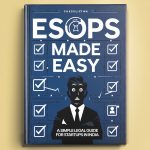You’ve spent time and effort structuring an ESOP for your company, but now comes the critical part—making sure your employees actually understand what it means for them. It’s not just about handing out stock options; it’s about making sure everyone knows how it benefits them and the company.
If your team doesn’t fully grasp what an ESOP is or how it works, you risk losing one of its main advantages: getting everyone aligned and motivated to work toward the company’s success. Poor communication can leave employees disconnected and uninterested in the long-term benefits, defeating the whole purpose of setting up an ESOP. So, how do you make sure that doesn’t happen?
Here’s a step-by-step practical guide on developing a communication strategy that helps employees understand, appreciate, and even take ownership of the ESOP plan.
- Ensure Clear and Accessible Communication
Clear communication is paramount. Your ESOP strategy should answer key questions: What does it mean for employees? How will they benefit? Why should they care? Develop a communication framework that addresses these areas comprehensively.
Present information in digestible formats, such as FAQs, infographics, and simple brochures. These materials should break down complex concepts into understandable pieces. For instance, an infographic could visually represent how the vesting process works or illustrate potential financial gains over time.
- Utilise Multiple Communication Channels
Employees have different preferences for how they receive information, making it necessary to implement a multi-channel communication strategy. Utilise a mix of communication methods to address these varying preferences:
- Communication by Means of Regular E-mail: Inform the employees about the progress of their ESOPs, share success stories, and update them about the performance of the company. Highlight key benchmarks achieved as a result of employees’ contributions to help them feel valued within the organisation.
- Intranet Resources: Allocate an independent section of your intranet to all ESOP-related materials, FAQs, and recorded webinars to help employees easily access it. This will also allow them to revisit the material as and when they need it.
- Organise town hall meetings or informal gatherings with ESOP experts where employees can ask questions and get real-time answers to their queries. This open dialogue will allow employees to raise concerns and seek clarification in a supportive environment.
You can use diverse channels so that all employees receive the same information in a format that they prefer.
- Emphasise on Tangible Benefits
It’s crucial to communicate not just what ESOPs are but also how they benefit employees directly. This includes tangible advantages, such as potential financial gain and retirement security.
Here are some effective ways of communicating those benefits:
- Financial Projections: Use simulations to determine potential increases based on different scenarios by applying company performance metrics. Graphically, illustrate how employee ownership can lead to increased wealth over time.
- Organise sessions focused on financial literacy that explain how ESOPs fit into an employee’s overall financial picture, including their tax obligations related to stock options. This empowers employees to make informed decisions about their ownership position.
- Provide Tools and Support Resources
To enhance employees’ understanding of ESOP benefits, founders might find it helpful to introduce practical tools, such as platforms like Carta, Pulley, or Ledgy, that allow employees to visualise their potential wealth accumulation and see their accumulated wealth in real time. This direct view of their financial future reinforces the rationale behind shared ownership.
It’s also essential to communicate the details of the ESOP. Avoid complicated legal jargon; instead, focus on straightforward explanations of employees’ rights, tax obligations, and participation benefits to make the concept of ESOPs more relatable and engaging.
- Measure Success
To determine whether your communication strategy is effective, establish metrics for success. Gather attitudinal data through surveys or feedback instruments focused on employee opinions about ESOPs. Also, metrics like employee retention rates and overall satisfaction scores should be considered to understand how the ESOPs impact organisational culture. Additionally, consider quarterly or semi-annual check-ins to assess employees’ understanding of the ESOP plan, helping you identify areas for clarification or improvement. This ongoing feedback loop ensures your ESOP strategy remains aligned with employee expectations and strengthens a sense of ownership within the team.
- Address Legal Considerations
While communicating about your ESOPs, it’s essential to remain compliant with legal requirements related to employee equity plans. Ensure all communications are clear with respect to vesting schedules, eligibility criteria, tax implications, and what happens if an employee leaves before fully vesting their options.
Conclusion
An ESOP, along with an effective communication strategy, will get your employees to think about their roles within your company in entirely new ways. Keeping benefits open and communicating through various channels while staying in touch with employees encourages building an ownership mindset, and that’s exactly what you need!
Looking to implement an ESOP and have questions about how to structure it effectively? Book a call with us using the link below for FREE guidance on this.


